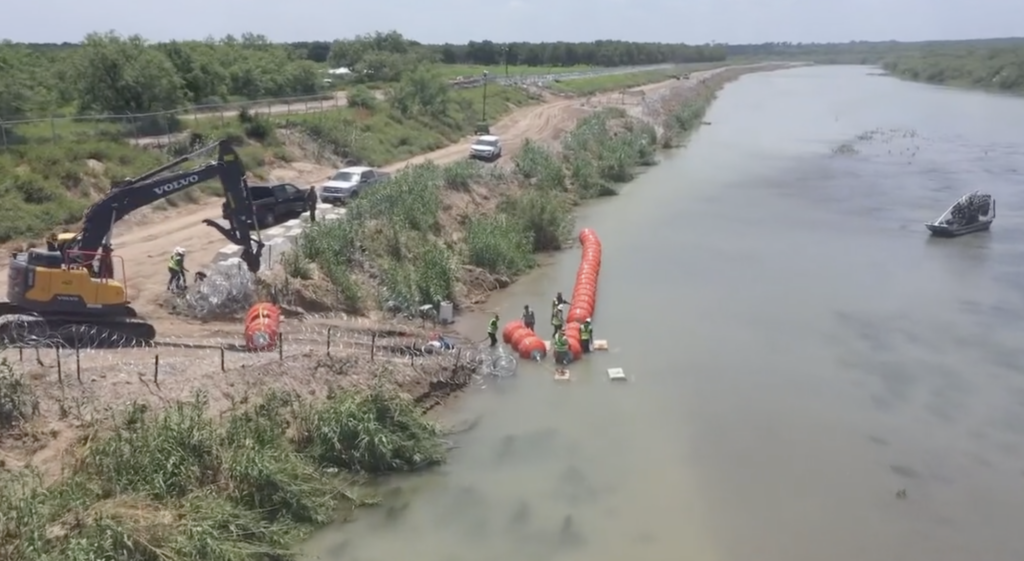A United States District Judge heard arguments on Tuesday regarding the floating buoy barrier installed by the state of Texas in the Rio Grande in a lawsuit brought forth by the Department of Justice (DOJ).
The DOJ took legal action against Texas last month for its “inhumane” handling of border security following the state’s decision to place buoys with saw-like components that prevent people from taking hold of the barrier across the Rio Grande River in hotbeds for migrant crossings.
Despite legal reprisals, Texas Governor Greg Abbott is rebuffing the federal government’s open border policy by doubling down on sweeping physical and legal approaches to try and steam the migrant invasion hammering the state and other border states bearing the brunt of the recent caravan invasions. Progressive critics of the Governor have called the floating barriers “deadly and inhumane.”

According to the Texas Tribune, the Department of Justice (DOJ) demanded immediate removal of the barrier in a hearing with a U.S. District Court Judge on Tuesday. “Hillary Quam, the U.S.-Mexico border coordinator for the U.S. State Department, testified during Tuesday’s hearing that the barrier has come up as an issue at the highest diplomatic levels with Mexico,” the outlet reported. “In diplomatic notes and in meetings with the U.S. secretary of state, Mexico has indicated the buoys are a treaty violation. Mexico’s president has mentioned the barrier six times in his daily press conferences since June.”
River buoy barriers embedded with saws are part of the Governor’s Operation Lone Star plan to stem the tide of migrants trying to circumnavigate border patrol, Texas Law Enforcement officials, and other natural and legal barriers the state has set up to keep the migrants out.
“Hundreds of people have died attempting to swim across the quick-moving river. The Governor believes the buoys will act as a deterrent for those hoping to cross illegally into the U.S. from Mexico and prevent loss of life. Southern states saw a record number of migrant deaths just last year, many of which were caused by the strong currents on the Rio Grande.”
TPUSA Live Feed
The move ignited a wave of criticism from open-border proponents who claim the barrier, like everything else to control the influx of illegal migration, is an inhumane “torture devise.” One X user wrote, “Greg Abbott added circular saws to his already horrific torture devices in the Rio Grande River, in an apparent attempt to first mutilate immigrants, then drown them.”
Congressman Julian Castro condemned the Governor’s border defenses by calling the devices “barbaric.” He added that Governor Abbot was “making border communities collateral damage” in his efforts to defend his state.
The Governor has defended his actions by reiterating that the barriers act as a deterrent, discouraging people from attempting to cross the border in the first place, while critics claim that the razor wire and buoys create a greater risk to those who dismiss the impediments and continue in their attempt to enter the U.S.
Texas has also been scrutinized for its bussing policy, which sends thousands of migrants from the border to self-declared sanctuary cities such as New York City, Chicago, and Washington D.C. The Mayor of New York City, Eric Adams, has resorted to handing out fliers to migrants asking them to consider vacating the city, as shelters are overwhelmed and residents become outraged by the sudden culture shift in their high-end communities. Black Chicago residents have even said that they are “sick and tired” of the city prioritizing new migrant arrivals over already-struggling, taxpaying residents.
Despite overwhelming pressure from open border advocates, the DOJ, and certain local businesses operating on the river, Governor Abbot has refused to remove the barrier and stated he was ready to take the battle to the Supreme Court if needed to protect his constituents and other Americans from the migration crisis.
This piece first appeared at TPUSA.






